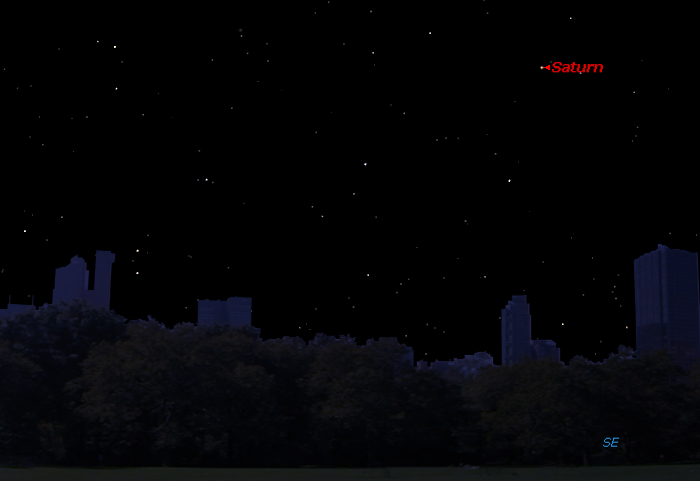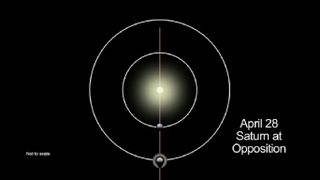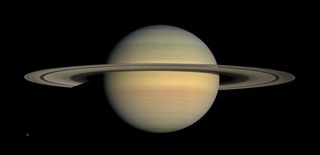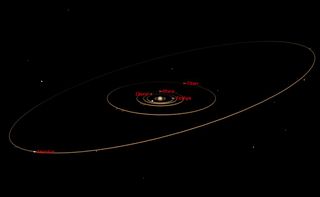See Saturn at Its Best In the Weekend Night Sky

In the early hours of Sunday morning (April 28), the planet Saturn reaches opposition. This places it exactly opposite the sun in our sky.
Opposition has several effects on Saturn. Most important, it marks its arrival in the evening sky. It is now visible all night long, a treat for the many people who consider this the most beautiful object in the sky. On Saturday and Sunday night, Saturn can be found in the southeastern sky, weather permitting.
Saturn's opposition also marks the planet's maximum brightness for the year, and the brightest it has been for a number of years. At magnitude 0.2, the ringed planet now outshines the first magnitude star Spica in the constellation Virgo. Astronomers measure the brightness of night sky in terms of magnitude, with lower numbers denoting exceptional brightness. [Photos of Saturn's Dazzling Rings]
You can easily spot Saturn and Spica by following the old rule: "Arc to Arcturus, then speed on to Spica." Start by following the arc formed by the handle of the Big Dipper away from the Dipper's bowl in a broad arc across the sky, first reaching Arcturus in kite-shaped Boötes, and then on to Spica and Saturn in Virgo. Sparkling Spica is on the right, steady Saturn on the left. Starlight, coming from a distant point, is deflected by the Earth's atmosphere and twinkles. A planet like Saturn is larger than a star in apparent size, and so is less affected by atmospheric turbulence, so shines with a steady light.

Saturn is most famous for its magnificent set of rings. All the outer planets have rings, but Saturn's are the brightest and most easily seen. Composed of small pieces of rock and ice, these rings are thin and transparent. When the rings pass in front of a star, the star's light shines through undiminished.
How much magnification do you need to see Saturn's rings? Although some people claim to have seen them with their unaided eyes, most people need a magnification of about 25 power to see that Saturn is an oval rather than a disk. For a really good view, 100 power is much better. Even so, Saturn appears much smaller in a telescope than most people expect. Although tiny, Saturn's perfection astounds all first-time viewers.
Besides its rings, Saturn has an amazing collection of moons, 62 in all. Its brightest moons are mostly in orbits in the same plane as the rings, as you can see in the chart. Its largest moon, Titan, is one of the two largest moons in the solar system; Jupiter's Ganymede is the other. These are the only two moons large enough to have extensive atmospheres. Titan is also the farthest object from Earth on which a spacecraft has landed, the unmanned Huygens probe in 2005.
Get the Space.com Newsletter
Breaking space news, the latest updates on rocket launches, skywatching events and more!

Titan can be seen easily in almost any telescope. Rhea, Tethys, and Dione can be seen with a 90mm telescope. The innermost moons, Mimas and Enceladus, are more challenging because the lie so close to the bright rings.
Iapetus is Saturn's most interesting moon. Its orbit is not in the plane of the rings, but is tilted at a steep angle. Like all large moons in the solar system, it always keeps one face turned towards its planet, but one side of Iapetus is coated with a dark sooty material. This results in Iapetus being much brighter when west of the planet that when it is to the east.

Because Saturn's moons can appear at any angle from the planet, you will need to use a planetarium software program to identify the individual moons and to distinguish them from background stars. Watching them change positions from night to night is fascinating.
Saturn holds something for every skywatcher. Everyone can enjoy spotting it in the sky, and those with telescopes can admire its rings and track the dance of its many moons.
Editor's Note: If you snap an amazing photo of Saturn and its rings and would like to share it with SPACE.com for a story or image gallery, please send comments and images to managing editor Tariq Malik at spacephotos@space.com.
This article was provided to SPACE.com by Starry Night Education, the leader in space science curriculum solutions. Follow Starry Night on Twitter @StarryNightEdu. Original article at SPACE.com.
Join our Space Forums to keep talking space on the latest missions, night sky and more! And if you have a news tip, correction or comment, let us know at: community@space.com.

Geoff Gaherty was Space.com's Night Sky columnist and in partnership with Starry Night software and a dedicated amateur astronomer who sought to share the wonders of the night sky with the world. Based in Canada, Geoff studied mathematics and physics at McGill University and earned a Ph.D. in anthropology from the University of Toronto, all while pursuing a passion for the night sky and serving as an astronomy communicator. He credited a partial solar eclipse observed in 1946 (at age 5) and his 1957 sighting of the Comet Arend-Roland as a teenager for sparking his interest in amateur astronomy. In 2008, Geoff won the Chant Medal from the Royal Astronomical Society of Canada, an award given to a Canadian amateur astronomer in recognition of their lifetime achievements. Sadly, Geoff passed away July 7, 2016 due to complications from a kidney transplant, but his legacy continues at Starry Night.
